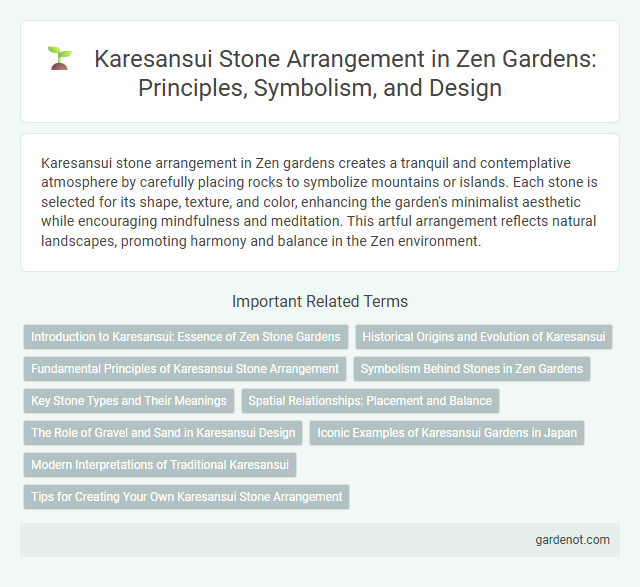Karesansui stone arrangement in Zen gardens creates a tranquil and contemplative atmosphere by carefully placing rocks to symbolize mountains or islands. Each stone is selected for its shape, texture, and color, enhancing the garden's minimalist aesthetic while encouraging mindfulness and meditation. This artful arrangement reflects natural landscapes, promoting harmony and balance in the Zen environment.
Introduction to Karesansui: Essence of Zen Stone Gardens
Karesansui, or Zen stone gardens, embody the essence of Zen philosophy through carefully arranged stones symbolizing mountains, islands, or animals, creating a meditative landscape. The minimalist design emphasizes empty space, called "ma," which invites contemplation and mindfulness by representing natural elements like water or clouds without physical presence. Precision in stone placement and raked gravel patterns reflects harmony, balance, and the impermanence central to Zen, making Karesansui a profound artistic expression of spiritual introspection.
Historical Origins and Evolution of Karesansui
Karesansui, or dry landscape gardens, originated in 14th-century Japan during the Muromachi period, epitomizing Zen Buddhist principles through minimalist stone arrangements symbolizing natural landscapes. These meticulously placed rocks represent mountains, islands, or animals, evolving from purely religious meditation spaces to widely appreciated artistic compositions. Over centuries, Karesansui designs adapted to reflect regional aesthetics and philosophical shifts while maintaining core Zen concepts of simplicity and tranquility.
Fundamental Principles of Karesansui Stone Arrangement
Karesansui stone arrangement centers on asymmetry, balance, and symbolism, representing natural landscapes through carefully placed rocks. Each stone embodies elements like mountains, islands, or animals, arranged to evoke harmony and evoke spiritual contemplation. The fundamental principles emphasize simplicity, naturalness, and the flow of energy (ki) within the garden space.
Symbolism Behind Stones in Zen Gardens
Karesansui stone arrangements in Zen gardens symbolize natural elements such as mountains, islands, or animals, representing the essence of the universe in a minimalist form. The placement and shapes of stones are carefully chosen to evoke a sense of balance, harmony, and spiritual contemplation. This symbolic use of stones guides meditation, reflecting Zen principles of simplicity and profound stillness.
Key Stone Types and Their Meanings
Karesansui, or Japanese dry landscape gardens, feature carefully selected stone types such as the tall, upright Tachigata stones symbolizing mountains, and flat, horizontal Asagata stones representing water or lakes. Ikekomi stones partially buried in the ground create a natural, aged appearance, often evoking island imagery. The deliberate placement and variety of these stones reflect concepts of harmony, stability, and serenity essential to Zen garden philosophy.
Spatial Relationships: Placement and Balance
Karesansui stone arrangement emphasizes precise spatial relationships, where each rock's placement reflects natural balance and harmony within the garden's minimalist design. The stones are positioned to create a dynamic interplay of asymmetry and balance, suggesting mountains, islands, or animals that invite contemplation. This deliberate arrangement fosters tranquility and depth, essential to the meditative experience of the Zen garden.
The Role of Gravel and Sand in Karesansui Design
Gravel and sand in Karesansui stone arrangements symbolize water and emptiness, creating a tranquil space that encourages meditation and reflection. The raked patterns in the gravel mimic ripples and waves, enhancing the visual flow and harmony between stones and surrounding elements. This minimalist use of gravel and sand emphasizes the Zen principles of simplicity, balance, and natural beauty.
Iconic Examples of Karesansui Gardens in Japan
The Ryoan-ji garden in Kyoto exemplifies Karesansui with its iconic fifteen stones arranged on white gravel, symbolizing islands in a sea of mist. Daitoku-ji temple's Karesansui garden features meticulous stone placements representing natural landscapes, emphasizing minimalism and Zen aesthetics. Saiho-ji, known as the Moss Temple, integrates stone arrangements with lush moss, creating a serene interpretation of traditional Karesansui design.
Modern Interpretations of Traditional Karesansui
Modern interpretations of traditional Karesansui stone arrangements emphasize minimalist designs while integrating contemporary materials such as metal and glass to enhance visual contrast. These adaptations maintain the symbolic significance of natural elements like rocks and gravel, representing mountains and water, but often incorporate asymmetrical layouts to evoke dynamic spatial interaction. Innovative approaches also involve interactive lighting and digital projections, reimagining the Zen garden experience for urban spaces and modern meditative practices.
Tips for Creating Your Own Karesansui Stone Arrangement
Choose stones of varying shapes and sizes to represent mountains and islands, placing larger stones asymmetrically to evoke natural landscapes. Use a balance of rough and smooth textures to enhance visual contrast, and arrange stones in odd numbers to maintain harmony and flow. Incorporate negative space intentionally to symbolize water or emptiness, ensuring the overall composition invites contemplation and tranquility.
Karesansui-stone arrangement Infographic

 gardenot.com
gardenot.com